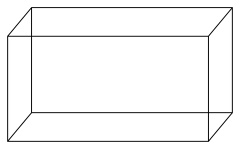Prism X
The prism with the edges of the lengths x cm, 2x cm, and 3x cm has a volume 29478 cm3. What is the area of the surface of the prism?
Final Answer:

Tips for related online calculators
Do you want to convert length units?
Tip: Our volume units converter will help you convert volume units.
Tip: Our volume units converter will help you convert volume units.
You need to know the following knowledge to solve this word math problem:
algebraarithmeticsolid geometryUnits of physical quantitiesGrade of the word problem
We encourage you to watch this tutorial video on this math problem: video1
Related math problems and questions:
- Cube
 The sum of lengths of cube edges is 56 cm. What are its surface and volume?
The sum of lengths of cube edges is 56 cm. What are its surface and volume? - Calculate 81939
 The block surface is 5,632 m². The lengths of the edges are in the ratio 1: 2 : 3. Calculate the volume of the cuboid.
The block surface is 5,632 m². The lengths of the edges are in the ratio 1: 2 : 3. Calculate the volume of the cuboid. - Cuboid - edges
 The cuboid has dimensions in a ratio of 4:3:5. The shortest edge is 12 cm long. Find: The lengths of the remaining edges The surface of the cuboid The volume of the cuboid
The cuboid has dimensions in a ratio of 4:3:5. The shortest edge is 12 cm long. Find: The lengths of the remaining edges The surface of the cuboid The volume of the cuboid - Cuboid edges
 Calculate the volume and surface of a cuboid whose edge lengths are in the ratio 2:3:4 and the longest edge measures 10cm.
Calculate the volume and surface of a cuboid whose edge lengths are in the ratio 2:3:4 and the longest edge measures 10cm. - Cuboid and cube
 A block with edges of lengths of 10 cm and 8 cm has the same volume as a cube with an edge of the length of 1 dm. Calculate the third dimension of the block. Compare the ratio of the surfaces of both bodies.
A block with edges of lengths of 10 cm and 8 cm has the same volume as a cube with an edge of the length of 1 dm. Calculate the third dimension of the block. Compare the ratio of the surfaces of both bodies. - Calculate 258
 Calculate the volume and surface area of a prism with a trapezoidal base and a height of 9 cm. The base is an isosceles trapezoid with bases of lengths 3 cm and 6 cm and arms of length 2.5 cm. The height of the base is 2cm.
Calculate the volume and surface area of a prism with a trapezoidal base and a height of 9 cm. The base is an isosceles trapezoid with bases of lengths 3 cm and 6 cm and arms of length 2.5 cm. The height of the base is 2cm. - Cube 1-2-3
 Calculate the volume and surface area of the cube ABCDEFGH if: a) /AB/ = 4 cm b) The perimeter of wall ABCD is 22 cm c) the sum of the lengths of all cube edges is 30 cm.
Calculate the volume and surface area of the cube ABCDEFGH if: a) /AB/ = 4 cm b) The perimeter of wall ABCD is 22 cm c) the sum of the lengths of all cube edges is 30 cm.
